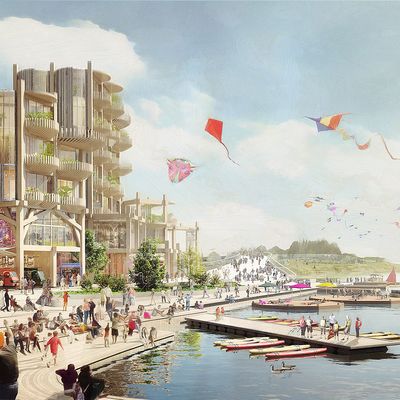
When the highest-of-high-tech master plans for Toronto’s waterfront, issued by Google’s sibling company Sidewalk Labs, arrived at my doorstep, I laughed. As I first riffled through the “Urban Innovations” section of the four-volume, 1,600-page boxed set (which you can also download), I came across a proposal for “lightweight, adjustable street furniture” — a.k.a. market stalls. There’s even a photograph of Rome’s Campo de’ Fiori, where these modular artichoke- and eggplant-vending platforms pop up every morning and get stowed by mid-afternoon, just as they have for centuries. Awesome technology!
As I sat and read, though, it became clear that this forward-to-the-past approach is not a gaffe or a ploy, but a goal. Billed as a data-crunching techno-utopia, Sidewalk’s vision for Quayside, the first 12-acre parcel of Toronto’s much vaster eastern waterfront, distills old-city principles and revives them for the digital age. Streets are designed around gasoline-free forms of transit: feet, wheelchairs, bicycles, and trolleys. Instead of having roads coated in asphalt that must be constantly jackhammered up, relaid, and patched, Quayside will have large hexagonal pavers that can be popped out and dropped back into place — essentially, oversize cobblestones.
It’s fascinating to see a software-powered universe come to grips with the physical world. The result is better than we had any reason to expect. Sidewalk’s CEO is Daniel Doctoroff, the deputy mayor under Michael Bloomberg who bequeathed to New York his signature project: Hudson Yards. Far from being the sequel to that district of glass megatowers, though, Quayside is the new city that Hudson Yards might have been: mixed, flexible, and humane. This is a megadevelopment organized not only around a corporate ledger, a politician’s ambitions, or a tech guru’s fantasies — though all those desires are in the mix — but also around a set of thoroughly road-tested urban needs. At Hudson Yards, financial mechanisms dictated what could be built. In Abu Dhabi’s showcase, Masdar City, technological goals dictated what should be built. Quayside, on the other hand, turns the paradigm around, first determining what kind of place people want to live in, then designing the technological and financial tools to make it happen. In some ways, the Sidewalk vision is that of a preindustrial city, only more orderly, more privatized, and with less early death.
And the high-tech material of the digital city is … trees. Sidewalk envisions putting up a wooden skyline, an entire neighborhood made of mass timber, fabricated in a computerized Toronto mill. That marriage of digital and timeless technologies is an exciting prospect, which would boost sustainable forestry, reduce emissions, speed up construction, and yield buildings that smell like northern forests. Sidewalk hired several firms — Snøhetta, Heatherwick Studio, and the mass-timber pioneer Michael Green Architecture — to demonstrate how a kit of prefabricated parts can be scrambled into a varied catalogue of forms.
I hope the site plan acquires more variety and nuance. It’s not yet architecture, but it’s already a vast improvement over the usual wall of waterfront towers. Here, buildings that range from four to 30 stories curve around a plaza that faces a marina. The most antique of the innovative elements is the stoa. In ancient Greek cities, that was the public arcade, where citizens (a category confined to adult men who weren’t enslaved or foreign-born) gathered to trade, talk, eat, haggle, and politick. Sidewalk has repurposed the term to mean a flexible ground-floor marketplace, where shops and food vendors can set up, expand, and contract — without being locked into high-cost, long-term leases. Exterior walls fold up in the warm months, and plastic awnings deploy in the rain.
There is a great deal in this vision that no company or government can promise. Sure, art studios could coexist with community meeting spaces and light-manufacturing workshops — but will they? Will sneaker chains gobble up prime square footage and shunt cobblers and grocery stores underground? Will anyone ever actually move the movable walls? (Does anyone, anywhere, ever?) Will savings and affordability materialize? Will the whole gemütlich lakeside village devolve into exactly the kind of high-gloss mall that Quayside was designed to avoid?
The plan, which challenges several layers of government to get behind it with votes and money, is an idealistic document. That’s both exciting and worrisome. Tech companies regularly utter reams of drivel on utopia as a distraction from their data-plundering ways. Opponents warn that Sidewalk, with Google’s might behind it, is bullying Canada’s democratic institutions into buying into its priorities. And Doctoroff, who has been on the government side of public-private partnerships, knows that even the best ideas have to stand the test of politics. His company has tried to inoculate itself against charges of being anti-democratic by citing the 21,000 Torontonians who have flocked to community meetings since the project was announced. It’s dangling carrots for timid officials, too, hoping to jump-start a long-discussed light-rail line by advancing investors $100 million worth in future revenue. The last 18 months were a test of how well the company’s leaders listened; the next six months will measure their ability to compromise.
So far, the signs are promising. Doctoroff’s statement was remarkable for all the things he said Sidewalk explicitly did not want to do: develop proprietary technology, control the broader waterfront area, collect and sell data, or impose a prepackaged urban vision on a citizenry with different ideas. Sidewalk has vowed not to use data to identify individuals, or to sell it to other companies. Yes, sensors will pick up if you’re shuffling slowly toward an intersection and instruct the Walk light to give you more time. But you don’t have to worry about your potential employer noticing that your pace has fallen off since last week and maybe you’re not in good enough shape for that promotion. Instead, the plan proposes the creation of a government-run Urban Data Trust, empowered to decide who collects information about whom and why.
It’s precisely the justified suspicion of monster corporations like Google that makes this project important: It puts citizens in a unique position to shape their digital future rather than merely respond to it. Some of the project’s most attention-getting bells and whistles offer far more than a frictionless lifestyle. A computerized garbage-disposal system can cut down on the need to ship waste to distant landfills. The planners have given serious thought to people with disabilities, too. Snow-melting sidewalks make it possible for the less sure-footed among us to leave their apartments after a snowstorm. A network of way-finding beacons would guide the blind through tricky, congested terrain. Given that driverless cars are coming, it would be far wiser for cities to design their streets for people this way and demand that car companies adapt than to wait and see what kind of road hogs roll off assembly lines in the coming decades, and then retool streets accordingly.
We often need the next technology to solve problems created by the slightly older kind. Online shopping, for instance, has turned the urban curbside into a mess of idling engines. When you shop online, the question animating the company that’s rushing your purchase to your doorstep is this: How can we move millions of packages to millions of addresses as cheaply and efficiently as possible? You may have a completely different question: How can I get my order delivered tomorrow and also get rid of the trucks that are constantly double-parked on my street? The first question matters to business, the second to civic life, and the answer to both may be in the Quayside model: Semis unload in a vast cargo-handling facility, where packages are sorted and distributed by delivery robot. You get your eBay purchase deposited at your doorstep, and when you leave your apartment, the street is quiet and clear.
Still, the master plan jumps from the 12-acre Quayside pilot project directly into the creation of a much larger district, where the company’s strategies for financing affordable housing and manufacturing wooden buildings could have the space and scale to succeed. That expansiveness jolted Waterfront Toronto, the public agency created to oversee the development, into issuing a tart warning not to move too fast or assume too much. A corporation proposes; government disposes.
Canada’s decisions will be watched around the world. In theory, Sidewalk’s ideas can be incubated in Quayside, refined in the larger eastern waterfront, and exported to cities everywhere. I wonder, though, whether the Toronto experience will actually spawn an uneven scatter of digitally governed metropolitan islands in an otherwise analog urban world. Sidewalk’s update of city living may plug right into Copenhagen, but it’s not clear what it can do for Lagos or Kolkata.
All this is cause for skepticism and care, not cynicism and rejection. #BlockSidewalk, a local organization that is trying to mobilize the same anti-corporate fervor in Toronto that drove Amazon away from Long Island City, accuses the company of “drown[ing] the public in detail.” Another way to put it is that the company has helped the public police it, rolling out a mile-long list of promises and aspirations that politicians and voters can hold it to. Details will give the new city texture; they are not a distraction but the substance of the plan itself. Without them, Quayside is just another megadevelopment deal.
*A version of this article appears in the July 8, 2019, issue of New York Magazine. Subscribe Now!































